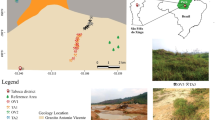Abstract
After the Chernobyl nuclear accident in 1986, 14 lichen specimens collected from Trabzon and Rize in 1995 were used to detect the amount of the fallout radionuclides. In this paper, radioactivity levels in the same species from the same localities were re-detected to compare with those of 1995. According to the results of the two studies, the radioactivity levels that this paper found for 137Cs and 40K are significantly lower than those of 1995 (about 5.5–127 folds for 137Cs, 5–17 folds for 40K). The level of 212Pb was acceptably small. The highest activities of the lichen species are seen in the locality of Helvacı (Trabzon, 100 m) and Çamlıhemşin (Rize, 1850 m) while the activities are medium in Bozdoğan (Trabzon, 150 m), Kemaliye (Trabzon, 750 m) and Çamlihemşin (Rize, 900 m). The activity values generally increase significantly depending on the altitudes. Since the measurements were performed 20 years after the Chernobyl accident in 1986, radionuclides of 134Cs having short half-life (2.062 y) have not been detected. All data was obtained with a coaxial high purity Ge detector of 15% relative efficiency and resolution 1.9 keV at the 1332 keV gamma of 60Co (Canberra, GC 1519 model).


Similar content being viewed by others
References
Baysal A, Yazıcı K (1995) Radioactive contamination in lichens collected from Akçaabat and Çamlıhemşin in the eastern Black Sea region of Turkey, 1994. Toxicol Environ Chem 48:145–148
Currie LA (1968) Limits for qualitative detection and quantitative determination. Application to radiochemistry. Anal Chem 40:586–593. doi:10.1021/ac60259a007
Chibowski S, Reszka M (2001) Investigation of Lubnin town environment contamination byradionuclides and heavy metals with application of Parmeliaceae lichens. J Radioanal Nucl Ch 247:443–446. doi:10.1023/A:1006798828071
Çevik U, Damla N, Koz B, Kaya S (2008) Radiological characterization around Afsin Elbistan coal-fired power plant in Turkey. Energ Fuel 22:428–432
Gokmen IG, Akgoz M, Gokmen A (1996) Chernobyl radioactivity on the Black Sea coast of Turkey. Fresenius J Anal Chem 355:736–738
Golubev AV, Golubeva VN, Krylov NG, Kuznetsova VF, Mavrin SV, Aleinikov AY, Hoppes WG, Surano KA (2005) On monitoring anthropogenic airborne uranium concentrations and U-235/U-238 isotopic ratio by Lichen – bioindicator technique. J Environ Radioactiv 84:333–342. doi:10.1016/j.jenvrad.2005.04.002
Köse A, Topçuoğlu S, Varinlioğlu A, Kopya AI, Azar A, Uzun O, Karal H (1994) The levels of Caesium Radionuclides in Lichens in the Eastern Black Sea area of Turkey. Toxicol Environ Chem 45:221–224
Krstic D, Stevanovic N, Milivojevic J, Nikezic D (2007) Determination of the soil-to-grass transfer of Cs-137 and its relation to several soil properties at various locations in Serbia. Isot Environ Healt S 43:65–73. doi:10.1080/10256010601154171
LaBrecque JJ, Cordoves PR (2007) Determination and spatial distribution of 137Cs in soils, mosses and lichens near Kavanayen, Venezuela. J Radioanal Nucl Ch 273:401–404. doi:10.1007/s10967–007-6847-2
L’Annunziata MF (2003) Handbook of radioactivity analysis. 2nd edn. Academic Press, London
McClenahen JR, Davis DD, Hutnik RJ (2007) Macrolichens as biomonitors of air-quality change in western Pennsylvania. Northeast Nat 14:15–26. doi:10.1656/1092-6194(2007)14[15:MABOAC]2.0.CO;2
Monnet F, Bordas F, Deluchat V, Chatenet P, Botineau M, Baudu M (2005) Use of the aquatic lichen Dermatocarpon luridum as bioindicator of copper pollution: accumulation and cellular distribution tests. Environ Pollut 138: 455–461. doi:10.1016/j.envpol.2005.04.019
Paatero J, Kulmala S, Jaakkola T, Saxen R, Buyukay M (2007) Deposition of Sb-125, Ru-106, Ce-144, Cs-134 and Cs-137 in Finland after the Chernobyl accident. Boreal Env Res 12:43–54
Papastefanou C, Manolopoulou M, Sawidis T (1989) Lichens and Mosses Biological monitors of radioactivity fallout the Chernobyl reactor accident. J Environ Radioactiv 9:199–207. doi:10.1016/0265-931X(89)90044-1
Papastefanou C, Manolopoulou M, Stoulos S, Ioannidou A, Gerasopoulos E (2005) Cesium-137 in air late after the Chernobyl reactor accident. J Radional Nucl Chem Lett 264:699–700. doi:10.1007/s10967-005-0773-y
Pipiska M, Hornik M, Vrtoch L, Augustin J, Lesny J (2007) Biosorption of Co2+ ions by lichen Hypogymnia physodes from aqueous solutions. Biologia 62:276–282. doi:10.2478/s11756-007-0047-y
Puhakainen M, Rahola T, Heikkinen T, Illukka E (2007) Cs-134 and (CS)-C-137 in lichen (Cladonia stellaris) in southern Finland. Boreal Env Res 12:29–35
Ramzaev V, Mishine A, Kaduka M, Basalaeva L, Brown J, Andersson KG (2007) Cs-137 and Sr-90 in live and dead reindeer lichens (genera Cladonia) from the “Kraton-3” underground nuclear explosion site. J Environ Radioactiv 93:84–99. doi:10.1016/j.jenvrad.2006.11.008
Rossbach M, Lambrecht S (2006) Lichens as biomonitors: global, regional and local aspects. Croat Chem Acta 79:119–124
Saka AZ, Çevik U, Bacaksız E, Kopya AI, Tıraşoğlu E (1997) Levels of caesium radionuclides in lichens and mosses from the province of Ordu in the Eastern Black Sea area of Turkey. J Radional Nucl Chem Lett 222:87–92. doi:10.1007/BF02034252
Skuterud L, Gaare E, Eikelmann IM, Hove K, Steinnes E (2005) Chernobyl radioactivity persists in reindeer. J Environ Radioactiv 83:231–252. doi:10.1016/j.jenvrad.2005.04.008
Topcuoglu S, Gungor N, Köse A, Varinlioglu A (1997) Translocation and depuration of 137Cs in tea plants. J Radioanal Nucl Ch 218:263–266. doi:10.1007/BF02039348
United Nations Scientific Committee on the Effects of Atomic Radiation (1982) On the effects of atomic radiation: ionizing radiation sources and biological effects, New York
Weissman L, Fraiberg M, Shine L, Garty J, Hochman A (2006) Responses of antioxidants in the lichen Ramalina lacera may serve as an early-warning bioindicator system for the detection of air pollution stres. Fems Microbiol Ecol 58:41–53. doi:10.1111/j.1574-6941.2006.00138.x
Author information
Authors and Affiliations
Corresponding author
Rights and permissions
About this article
Cite this article
Yazici, K., Ertuğral, B., Damla, N. et al. Radioactive Contamination in Lichens Collected from Trabzon and Rize in the Eastern Black Sea Region, Turkey, and a Comparison with that of 1995. Bull Environ Contam Toxicol 80, 475–479 (2008). https://doi.org/10.1007/s00128-008-9441-6
Received:
Accepted:
Published:
Issue Date:
DOI: https://doi.org/10.1007/s00128-008-9441-6




